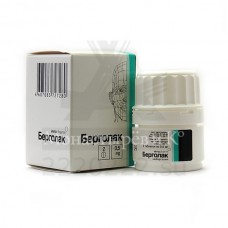Expiration date: 01/2027
Clinico-pharmacological group
(Dopamine receptor agonist. Inhibitor of prolactin secretion)
Release form, composition and packaging
Tablets white color, oblong, lenticular, scored on one side.
1 tablet contains cabergoline 500 mcg
Other ingredients: leucine, lactose anhydrous (ektapress), magnesium stearate.2 - plastic bottles (1) - packs of cardboard.
8 PCs - plastic bottles (1) - packs of cardboard.
Pharmacological action
Dopamine receptor agonist, Ergoline derivative, inhibits the secretion of prolactin. Stimulates dopamine D2-receptors lactotropic cells of the pituitary gland in high doses has a Central dopaminergic effect. Reduces the concentration of prolactin in the blood, restores menstrual cycle and fertility. By reducing the concentration of prolactin in the blood of women recovering pulsating secretion of gonadotropins and the release of luteinizing hormone in the middle of the cycle, anovulatory cycles are eliminated and increases the concentration of estrogen in the body, reduces the severity of hypoestrogenic (increase in body mass, fluid retention, osteoporosis) and hyperandrogenic (acne, hirsutism) symptoms.In men reduces hyperprolactinemia caused decreased libido, impotence (decrease in the concentration of prolactin increases the concentration of testosterone), gynecomastia, lactoria. Regress macroadenoma of the pituitary gland and associated symptoms (headache, disturbance fields and visual acuity, function of the cranial nerves and the anterior pituitary). Reduces the concentration of prolactin in patients with prolactinomas and pseudoprojection (without reducing the size of pituitary adenoma). The decrease in the concentration of prolactin observed after 3 h after administration and lasts for 7-28 days in patients with hyperprolactinemia and 14-21 days in suppressing postpartum lactation. The decrease in the concentration of prolactin occurs within 2-4 weeks of treatment.
Pharmacokinetics
Suction and raspredelenie high, do not depend on food intake. The time to reach Smahv plasma - 0.5-4 h. plasma protein Binding - 41-42%.T1/2 is 63-68 hours in healthy volunteers and 79-115 h - in patients with hyperprolactinemia. Due to the long T1/2 as the equilibrium concentration is achieved after 4 weeks of therapy.Metabolism and wavegeneration metabolized. The metabolites have a significantly smaller effect on the suppression of prolactin secretion compared with cabergoline.Excreted by the kidneys and through the intestines about 18% and 72% of the dose of cabergoline, respectively, while in the form of unchanged cabergoline the news is 2-3%.
Dosage
The drug is taken orally, during meals.To prevent lactation after childbirth, and 1 mg dose (2 tab.) on the first day after birth.For suppression of established lactation - 0.25 mg (1/2 tab.) 2 times/day every 12 hours for 2 days (total dose 1 mg).To reduce the risk of orthostatic hypotension breast-feeding mothers, a single dose of the drug Bergolak should not exceed 0.25 mg. For the treatment of disorders associated with hyperprolactinaemia: the recommended initial dose is 0.5 mg per week in 1 reception (1 tab.) or in 2 doses (1/2 tab., for example, Monday and Thursday). An increase in the weekly dose should be done gradually by 0.5 mg at monthly intervals until the optimal therapeutic effect. A therapeutic dose is usually 1 mg per week but can range from 0.25 to 2 mg per week.The maximum dose for patients with hyperprolactinemia should not exceed 4.5 mg per week.Depending on tolerability, the weekly dose of the drug Bergolak can be taken once or divided into 2 or more receptions in a week. Splitting the weekly dose into multiple methods is recommended when administering the drug in a dose of 1 mg per week.The likelihood of developing side effects can be reduced by starting therapy with the drug Bergolak with a low dose (e.g. 0.25 mg, 1 times a week) with subsequent gradual increase to a therapeutic dose. To improve tolerability in the occurrence of significant side effects may be a temporary reduction in dose with a subsequent more gradual increase (e.g., increase by 0.25 mg per week every 2 weeks).
Overdose
Symptoms: nausea, vomiting, abdominal pain, constipation, decreased blood pressure, orthostatic hypotension, headache, cramps of calf muscles, sudden fatigue, sweating, drowsiness, agitation, psychosis, hallucinations.Treatment: gastric lavage, blood pressure control, appointment of antagonists of dopamine receptors (phenothiazines, butyrophenone, thioxanthene, metoclopramide).Medicinal vzaimodeistviia recommended the simultaneous use of ergot alkaloids and their derivatives (with long-term therapy cabergoline).While the use of antagonists of dopamine receptors (phenothiazines, butyrophenone, tioksantena, metoclopramide) may weaken the effect of cabergoline.It is not recommended concurrent use of cabergoline with macrolides due to the possible increase in the concentration of cabergoline in the blood plasma. The mechanism of interaction of macrolides with cabergoline quite unknown, but, apparently, due to the ability of macrolides and cabergoline competitive to inhibit the cytochrome P450 system.
Pregnancy and lactation
Since controlled clinical studies using cabergoline in pregnant women have not been conducted, the appointment of the drug during pregnancy is possible only in case of extreme necessity, where the potential benefits from the use of the drug for women are much greater than the possible risk to the fetus.Pregnancy should be avoided for at least one month after discontinuation of cabergoline, given the long T1/2 of the drug and limited data on its effects on the fetus (according to available data the use of cabergoline in the dose 0.5-2 mg per week, about the of disorders associated with hyperprolactinemia, were not accompanied by an increase in the frequency of miscarriages, premature birth, multiple pregnancy and congenital malformations).If the pregnancy occurred on the background of treatment cabergoline, you should consider the appropriateness of drug withdrawal, taking into account the ratio of potential benefit from the use of the drug for women and the possible risk to the fetus.Since cabergoline suppress lactation, the drug should not be administered to mothers who wish to breast-feed. During treatment cabergoline should stop breastfeeding.
Side effects
Side-effects are usually transient, but the severity is slightly or moderately expressed and are dose-dependent nature. Occur mainly during the first 2 weeks of therapy and in most cases disappear on their own with continued treatment or a few days after discontinuation of cabergoline.From the side of cardiovascular system: heart, rush of blood to the skin, spasms of the vessels of the fingers (as with other ergot derivatives, cabergoline may have vasoconstrictor effect) valvulopathy, rarely - orthostatic hypotension (long-term treatment cabergoline - hypotensive effect), noted asymptomatic decrease in blood pressure during the first 3-4 days after birth (systolic - more than 20 mm Hg.St., diastolic more than 10 mm Hg.St.).From the nervous system: dizziness/vertigo, headache, fatigue, drowsiness, depression, mania, asthenia, paresthesia, syncope.From the digestive system: nausea, vomiting, epigastric pain, abdominal pain, constipation, gastritis, dyspepsia, abnormal liver function.Allergic reactions: hypersensitivity reactions, skin rash.Other: mastodynia, epistaxis, transient hemianopia, muscle cramps of the lower extremities, alopecia, increased activity of creatine kinase in blood serum, edema, pleural fibrosis, respiratory problems (including respiratory failure).
Terms and conditions storage
List B. the Drug should be stored out of reach of children at temperature not exceeding 25°C. shelf Life - 2 years.
Testimony
— prevention of postpartum lactation— suppression of established lactation post— treatment of disorders associated with hyperprolactinemia, including amenorrhea, oligomenorrhea, anovulation, galactorrhea,— prolactinsecreting pituitary adenomas (micro - and macroprolactinomas), idiopathic hyperprolactinemia, syndrome of an empty Turkish saddle in combination with hyperprolactinemia.
Contraindications
— age 16 years (safety and effectiveness in these patients have not been established), a rare hereditary forms of galactose intolerance, congenital lactase deficiency or lapp malabsorption of glucose-galactose (because the drug contains lactose),— hypersensitivity to cabergoline or other components of the drug, as well as to any ergot alkaloids.
With caution should designate product under the following conditions and/or diseases:— hypertension, which developed on the background of pregnancy (e.g., preeclampsia) or postpartum hypertension, severe cardiovascular disease, Raynaud's syndrome,— peptic ulcer, gastrointestinal bleeding,— severe hepatic insufficiency— severe psychotic and cognitive disorders (including in history), the presence of fibrotic changes of the heart (valvulopathy) and respiratory system (pleural effusion/pleural fibrosis), including in the anamnesis— simultaneous treatment with drugs that have hypotensive effect (due to the risk of orthostatic hypotension).
Special instructions
Before the appointment of cabergoline necessary to conduct a full investigation of pituitary function.With increasing doses of the drug, patients should be under medical supervision to establish the lowest dose that provides therapeutic effect. During treatment, regularly (1 per month) to determine the concentration of prolactin in serum. Normalization of prolactin concentration is usually observed within 2-4 weeks of therapy cabergoline.After the cancellation of cabergoline usually there is a relapse of hyperprolactinemia, however, some patients maintained a persistent decrease in the concentration of prolactin in a few months. For most women, ovulatory cycles persist for at least 6 months after withdrawal of cabergoline.Cabergoline restores ovulation and fertility in women with hyperprolactinemic hypogonadism. Since pregnancy may occur prior to the recovery of menstruation, it is recommended to conduct pregnancy tests at least once in 4 weeks during the period of amenorrhea, and after the restoration of menstruation every time marked delay of menstruation for more than 3 days.You should use a barrier method of contraception during treatment cabergoline and after drug withdrawal until recurrence of anovulation. If pregnancy occurred during treatment, you should consider discontinuation of the drug. Women who have become pregnant should be under medical supervision for the timely detection of symptoms increase pituitary gland (during pregnancy may increase the size of existing tumors of the pituitary gland).After long-term administration of cabergoline patients had pleural effusion/pleural fibrosis and valvulopathy, so cabergoline should be used with caution in patients with ongoing symptoms and/or clinical symptoms of disorders of heart function, including in anamnesis.Patients with hypertension, developed on the background of pregnancy (e.g., preeclampsia) or postpartum hypertension cabergoline prescribed only in cases where the potential benefits from the use of the drug significantly outweigh the potential risks.Application of cabergoline causes drowsiness. In patients with Parkinson's disease the use of agonists of dopamine receptors can cause sudden falling asleep. In such cases it is recommended to lower the dose of cabergoline or stop the therapy.Studies on the use of cabergoline in elderly patients with disorders associated with hyperprolactinemia, were not conducted..
Effects on ability to drive vehicles and management mekhanizmami period of treatment is recommended to refrain from driving and other activities that require high concentration and psychomotor speed reactions.
Use in hepatic impairment
With caution should designate product in severe liver failure.



